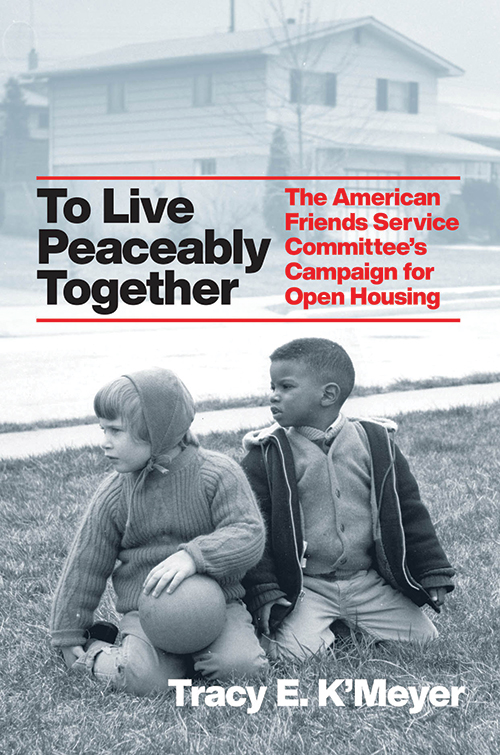
To Live Peaceably Together: The American Friends Service Committee’s Campaign for Open Housing
Reviewed by Tom Head
September 1, 2022
By Tracy E. K’Meyer. The University of Chicago Press, 2022. 240 pages. $45/hardcover; $44.99/eBook.
If you would like to know what Quakers and American Friends Service Committee (AFSC) did to mitigate racial barriers to housing in the decades after World War II, this is the book for you. The author, Tracy K’Meyer, is a professor of history at the University of Louisville and has focused her career on extensive research and writing about modern social movements in the United States.
While Quakers in the United States and AFSC in particular are predominately White, K’Meyer documents how AFSC made fervent, early, and broad attempts to promote access to housing for all. It was an uphill battle, and the efforts of AFSC often failed, but slowly, very slowly, their advocacy for housing justice did achieve moments of success. K’Meyer’s book delves deeply into the history of AFSC and recounts Quaker efforts to achieve housing equity in Chicago, Ill.; Philadelphia, Pa.; the San Francisco Bay Area of California; and other parts of the country.
One message of the book that comes through quite clearly is that it has not been easy to overcome the racial discrimination that stands in the way of equal access to housing in the United States. African Americans have been blocked from housing by legal restrictions, commercial real estate norms and practices, and outright harassment and violence. For decades, People of Color were deprived of the dream of owning a home or even renting housing in integrated communities. In many ways, the story of the post-WWII years is a sad and discouraging one, especially for People of Color. But there were moments of progress, and Quakers contributed to the movement in significant ways.
Along the journey to encourage the campaign for open housing, there were high moments, too. There were times when the work was interwoven with the actions of movement leaders such as Martin Luther King Jr., Stokely Carmichael, Bayard Rustin, Jesse Jackson, and Andrew Young as well as a number of AFSC staffers.
Having taken a deep dive into AFSC national archives, K’Meyer chronicles every step along the way, revealing that Quakers were both reflective and assertive in their efforts to promote equity in housing. Her very thorough account of all of the many intricacies of AFSC’s Campaign for Open Housing may be a little too detailed for some readers, but I have no doubt that this book will be a good addition to every monthly meeting’s library. This was a significant era in twentieth-century Quaker history, and the book documents our engagement in fair housing efforts accurately and quite usefully, offering a considerably informative background as to how we might move on from here to achieve further racial equity in the future.
Even though much progress was eventually made with respect to housing, the march toward combating racism and inequality continues onward today in so many ways. To Live Peaceably Together helps us review some critical moments in our historical efforts toward living our testimony of equality, and it encourages, supports, and informs the ongoing journey toward all dimensions of racial justice.
Tom Head, a member of Chico (Calif.) Meeting, has moved to California after a 41-year career in Oregon at George Fox University, now professor of economics emeritus. He continues to be an active participant in Friends Association for Higher Education, Friends Committee on National Legislation, and Western Friend magazine.


